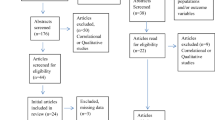Abstract
Background
Success of bariatric surgery is largely dependent on patients’ abilities to change their lifestyle and underlying psychosocial and behavioral factors; these factors should be carefully scrutinized. However, no consensus or guidelines exist for these evaluations.
Materials and Methods
To get a better understanding of the practice of bariatric surgery and bariatric psychology in The Netherlands and its evolution, a survey of bariatric surgery programs was conducted.
Results
Between 2000 and 2005, performance of bariatric surgery in The Netherlands has increased from 564 to more than 2,000 annually, mostly adjustable gastric banding. Most hospitals have a multidisciplinary selection process, and in 89% of the cases, a mental health specialist was involved.
Conclusion
Bariatric surgery in The Netherlands has increased tremendously; however, it is mostly limited to restrictive procedures, and there is no consensus regarding the psychological evaluation of patients.
Similar content being viewed by others
References
CBS. Gerapporteerde gezondheid en levensstijl (Self-reported health and lifestyle). Statistics Netherlands; 2005 Available at: http://statline.cbs.nl/StatWeb/Table.asp?LYR=G2:0,G3:6&LA=nl&DM=SLNL&PA=03799&D1=242,254,267-270&D2=0-17&STB=G1&HDR=T (accessed May 2007).
Schouten R, Van Dielen FMH, Van Gemert WG, et al. Conversion of vertical banded gastroplasty to roux-en-Y gastric bypass results in restoration of the positive effect on weight loss and co-morbidities: evaluation of 101 patients. Obes Surg 2007;17:622–30.
Van Hout GMC, Leibbrandt AJ, Jakimowicz JJ, et al. Bariatric surgery and bariatric psychology: general overview and the Dutch approach. Obes Surg 2003;13:926–31.
Hsu LK, Benotti PN, Dwyer J, et al. Nonsurgical factors that influence the outcome of bariatric surgery: a review. Psychosom Med 1998;60:338–46.
Zeheter J, Holzinger F, Triaca H, et al. A 6-year experience with the Swedish adjustable gastric band. Prospective long-term audit of laparoscopic gastric banding. Surg Endosc 2005;19:21–8.
Van Hout GCM, Boekestein P, Fortuin FAM, et al. Psychosocial functioning following bariatric surgery. Obes Surg 2006;16:787–94.
Van Hout GCM, Jakimowicz JJ, Fortuin FAM, et al. Weight loss and eating behavior following vertical banded gastroplasty. Obes Surg 2007;17:1226–34.
Van Hout GCM, Fortuin FAM, Pelle AJM, et al. Psychosocial functioning, personality, and body attitude following vertical banded gastroplasty. Obes Surg 2008; in press.
Buchwald H, Williams SE. Bariatric surgery worldwide 2003. Obes Surg 2004;14:1157–64.
Bauchowitz AU, Gonder-Frederick LA, Olbrisch M, et al. Psychosocial evaluation of bariatric surgery candidates: a survey of present practices. Psychosom Med 2005;67:825–32.
Dziurowicz-Kozlowska AH, Wierzbicki Z, Lisik W, et al. The objective of psychological evaluation in the process of qualifying candidates for bariatric surgery. Obes Surg 2006;16:196–202.
Rydén O, Hedenbro JL, Frederiksen SG. Weight loss after vertical banded gastroplasty can be predicted: a prospective psychological study. Obes Surg 1996;6:237–43.
Fabricatore AN, Crerand CE, Wadden TA, et al. How do mental health professionals evaluate candidates for bariatric surgery? Survey results. Obes Surg 2006;16:567–73.
Gastrointestinal surgery for severe obesity 25–27 March 1991. National Institutes of Health Consensus Development Conference Draft Statement. Obes Surg 1991;1:257–66.
Fried M, Hainer V, Basdevant A, et al. Interdisciplinary European guidelines for surgery for severe (morbidly) obesity. Obes Surg 2007;17:260–70.
Santry HP, Chin MH, Cagney KA, et al. The use of multidisciplinary teams to evaluate bariatric surgery patients: results from a national survey in the U.S.A. Obes Surg 2006;16:59–66.
Zelissen PMJ, Mathus-Vliegen EHM. Behandeling van overgewicht en obesitas bij volwassenen: voorstel voor een richtlijn (Treatment of overweight and obesity in adults: proposal for a guideline). Ned Tijdschr Geneeskd 2004;148:2060–65.
Wadden TA, Sarwer DB. Behavioral evaluation of candidates for bariatric surgery: a patient oriented approach. Surg Obes Relat Dis 2006;2:171–9.
Van Strien T. Dutch eating behaviour questionnaire. Manual. Bury St. Edmunds: Thames Valley Test Company Ltd. 2002.
Van Strien T. Nederlandse Vragenlijst voor Eetgedrag (NVE). Handleiding. (Dutch Eating Behavior Questionnaire (NVE). Manual). Amsterdam: Boom test uitgevers 2005.
Schreurs PJG, Willige G van de, Tellegen B, et al. De Utrechtse Coping Lijst. Omgaan met problemen en gebeurtenissen. Handleiding (The Utrecht Coping List. Coping with Problems and Events. Manual). Lisse: Swets & Zeitlinger 1988.
Luteijn F, Starren J, van Dijk H. Herziene handleiding NPV (Revised manual NPV). Lisse: Swets & Zeitlinger 1985.
Arrindell WA, Ettema JHM. SCL-90. Handleiding bij een multidimensionele psychopathologie-indicator (SCL-90. Manual for a multidimensional psychopathology-indicator). Lisse: Swets & Zeitlinger 1986.
Luteijn F, van der Ploeg FAE. Handleiding bij de GIT (Manual for the GIT). Lisse: Swets & Zeitlinger 1983.
Luteijn F, Kok AR, van der Ploeg FAE. NVM, Nederlandse Verkorte MMPI, Handleiding, herziene uitgave (NVM, Dutch Short MMPI, Manual, Revised Edn). Lisse: Swets & Zeitlinger 1985.
Wilde GJS. Neurotische labiliteit gemeten volgens de vragenlijstmethode (Neurotic lability measured according to the questionnaire method). Amsterdam: Van Rossum 1970.
Garner DM, Olmsted MP, Polivy J. Development and validation of a multidimensional eating disorder inventory for anorexia nervosa and bulimia. Int J Eat Disord 1983;2:15–34.
Van Strien T. Eating Disorder Inventory II. Nederlandse versie (EDI-II NL). Handleiding. (Eating Disorder Inventory II. Dutch version (EDI-II NL). Manual.) Lisse: Swets & Zeitlinger BV. 2002.
Basdevant A, Paita M, Rodde-Dunet M-H, et al. A nationwide survey on bariatric surgery in France: two years prospective follow-up. Obes Surg 2007;17:39–44.
DeMaria EJ. Bariatric surgery for morbid obesity. N Engl J Med 2007;356:2176–83.
Acknowledgment
This study was supported by the Scientific Research Fund of the Catharina Hospital, Eindhoven, The Netherlands.
Author information
Authors and Affiliations
Corresponding author
Rights and permissions
About this article
Cite this article
van Hout, G.C.M., Vreeswijk, C.M.J.M. & van Heck, G.L. Bariatric Surgery and Bariatric Psychology: Evolution of the Dutch Approach. OBES SURG 18, 321–325 (2008). https://doi.org/10.1007/s11695-007-9271-3
Received:
Accepted:
Published:
Issue Date:
DOI: https://doi.org/10.1007/s11695-007-9271-3




